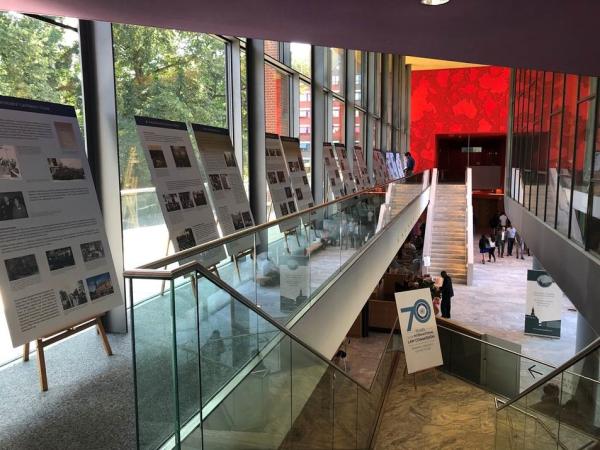This week the International Law Commission starts its seventieth session in New York. For the past seventy years, the Commission has played an indispensable role in the progressive development of international law and its codification. To mark the seventieth anniversary of the Commission, a photo exhibit is on display at the United Nations Headquarters in New York, which features images of the Peace Palace Library photo collection. The exhibit explores the achievements of the Commission and places them in historical context – a history in which the city of The Hague plays a special role.
Guest blog by Bart Smit Duijzentkunst
This week the International Law Commission starts its seventieth session in New York. For the past seventy years, the Commission has played an indispensable role in the “progressive development of international law and its codification”, as Article 13(1)(a) of the Charter of the United Nations has it. Its achievements range from laying the groundwork for the 1969 Vienna Convention on the Law of Treaties and the 1998 Rome Statute of the International Criminal Court to adopting the 2001 articles on the responsibility of States for internationally wrongful acts.
To mark the seventieth anniversary of the Commission, a photo exhibit is on display at the United Nations Headquarters in New York, which features images of the Peace Palace Library Photo collection. The exhibit explores the achievements of the Commission and places them in historical context – a history in which the city of The Hague plays a special role.
The movement to “codify” international rules – to turn unwritten custom into written conventions – predates the establishment of the International Law Commission by decades, if not centuries. The first organized efforts arose in 1873, when two organizations were established to further the codification of international law: the Institut de droit international and the Association for the Reform and Codification of the Law of Nations (now known as the International Law Association (ILA)). Among the founders of the Institut was a young Dutch lawyer, who would later win the Nobel Peace Prize for his contributions to the development of international law and whose name is closely associated with The Hague: Tobias M.C. Asser.
Both the Institut and the ILA established early links with The Hague, holding their second and third annual conferences in the city, respectively. At that time, codification was a political ideal on par with disarmament and trade liberalisation. The codification movement was considered significant enough to deserve a mocking cartoon in the Nederlansche Spectator, a Dutch satirical newspaper. Published at the occasion of the third ILA conference held in The Hague in 1875, it is entitled “Congress for the Codification of the Law of Nations”; the comment reads “A Babylonian confusion of words that will [surely] lead to peace.” Signifying the importance of the event, then Prime Minister Jan Heemskerk Azn. of the Netherlands is depicted in the bottom left, together with former Prime Minister Gerrit de Vries Azn.
The role of the city of The Hague in the 1899 and 1907 peace conferences is well known. The conferences codified important rules on the conduct of warfare and established the Permanent Court of Arbitration, the first permanent institution for the peaceful settlement of disputes between States. During the second peace conference in 1907, the corner stone was laid for the Peace Palace, the home of the Permanent Court of Arbitration which now also houses the International Court of Justice.
Readers may be less familiar with another conference on international law that took place in The Hague in the first half of the 20th century. On 13 March 1930, the League of Nations convened a Conference for the Codification of International Law in The Hague’s Hall of Knights. The conference considered topics suggested by the League’s Committee for the Progressive Codification of International Law, a predecessor of the International Law Commission. The topics on the agenda included nationality, territorial waters and State responsibility. While the conference made some progress on the first item, it did not achieve notable results on the other topics.
However, the conference drew valuable lessons from its experience with the codification process, in particular regarding the importance of preparing draft conventions prior to convening a diplomatic conference. These were taken into account by the newly-established General Assembly of the United Nations, when it considered novel mechanisms to promote the “progressive development of international law and its codification”. The Statute of the International Law Commission, adopted in 1947, reflects many of the lessons learned in The Hague in 1930.
The Hague continues to be central to the progressive development of international law and its codification. Members of the Commission, current and former, regularly appear at its international courts and tribunals, either as counsel or on the bench. The International Court of Justice frequently refers to the work of the Commission. In turn, the Court’s judgments contribute to a better understanding of the international rules and procedures proposed by the Commission.
Furthermore, the International Criminal Court and ad hoc tribunals based in The Hague shape the field of international criminal justice on a daily basis. In addition, the Hague Conference on Private International Law (first convened by Tobias M.C. Asser in 1893) continues to develop harmonized rules and principles of private international law. Last but not least, the Hague Academy of International Law has instilled in generations of international lawyers a commitment to a stable and just international legal order. All in all, the city of The Hague and its institutions continue to ensure that the seeds of seventy years of work of the International Law Commission are sown in fertile ground.
